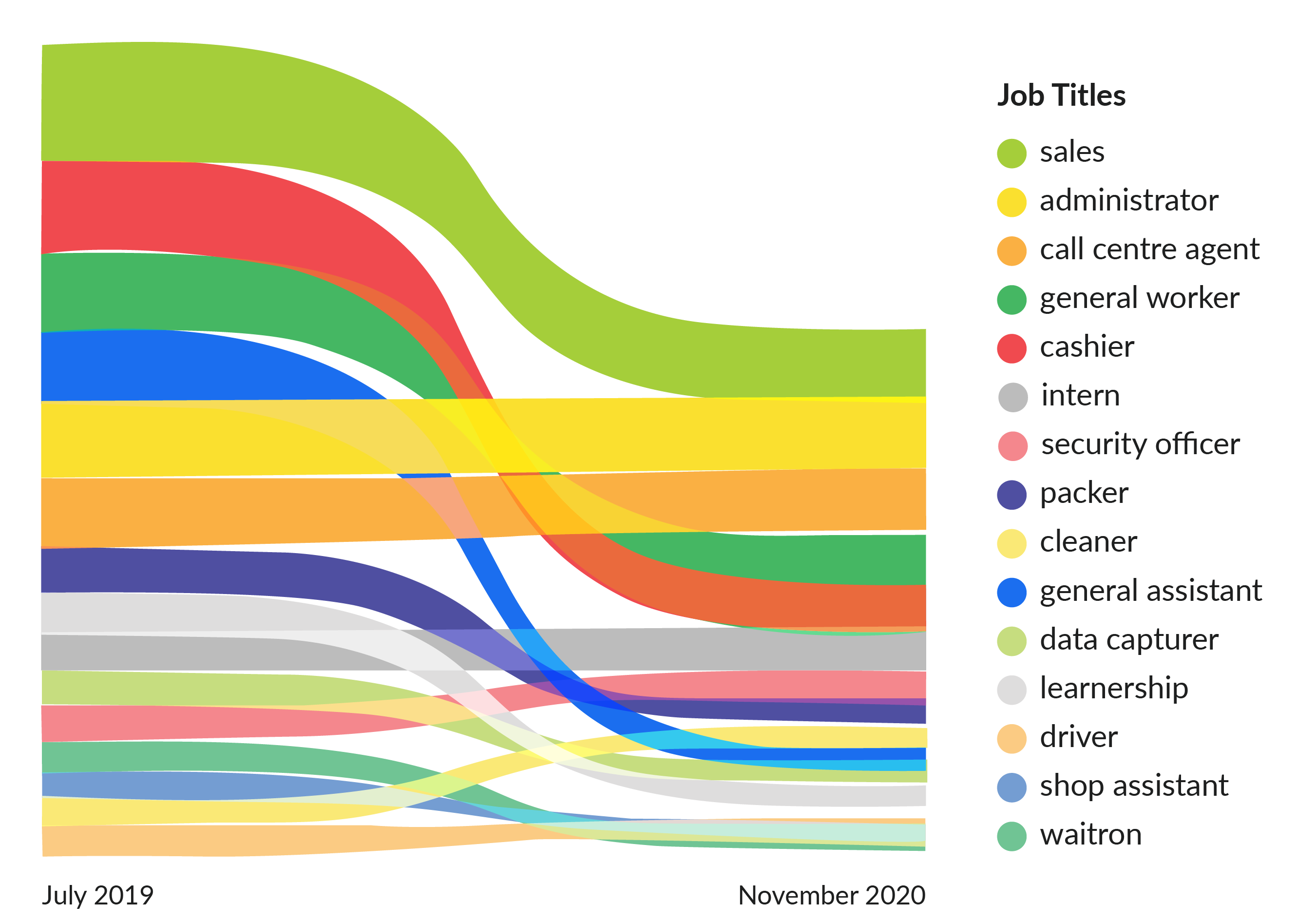

SA Youth connects young people to work and employers to a pool of entry level talent.
Are you a work-seeker?
Several prior editions of Breaking Barriers have shared data and research on jobless growth and zig-zagging pathways to employment, as well as promising solutions for these challenges. The COVID-19 pandemic has accelerated many of these trends, amplified others, and forced the rethinking of our traditional assumptions and historic approaches. The June 2021 Statistics South Africa employment data reinforces this—only 79,000 formal sector employment opportunities have been created in the last quarter. The unemployment rate remains unchanged, suggesting that the shape of economic and jobs recovery will be very different from past benchmarks—and may prolong this downward trend.
The pandemic saw a 5-percentage point fall in the proportion of employed youth, which comes on the back of already very high youth unemployment rates. We know that crises hit hardest those who have the most tenuous attachment to the labour market—young women in particular, who saw double the rate of retrenchments compared to men.
Figure 1: Proportion of South African Employed Youth in Global Crisis (historic and present)

Source: N Rankin (2021) Harambee Youth Employment Accelerator
This can be attributed, in part, to the collapse of short-term and contract jobs during the pandemic. However, the recovery shows that these are now coming back more quickly than longer-term, more permanent jobs. In an environment of uncertainty, we can expect this imbalance to continue, exposing young people to a very different opportunity set of entry-level work.
The decline in permanent jobs is likely here to stay. We must therefore find new ways for young people to reliably enter and stay within the labour market—the theme of this edition of Breaking Barriers.
Just like the Japanese hotel that fired half its robots in 2019, the global response to the pandemic has shown us the power of data, machine learning and automation, and their limits. Frontline responses in public health, social care and financial support have depended heavily on human-to-human interactions. Complex problems and broken structures have tested the limits of the technological solutions we do have. Technology may need humans more than the other way around, a view that’s borne out by evidence that the fastest-growing sectors of the economy place a premium on human skills deployed in tandem with technology.
There’s reason to believe South Africa is particularly well positioned to take advantage of this shift. In April, South Africa’s global business service industry edged out other countries like India and the Philippines to claim the top award of Most Favoured Offshore CX Delivery Location for 2021, despite (and perhaps even accelerated by) the pandemic. The research highlighted South Africa’s human advantage: a skilled and young English-speaking workforce with high empathy levels and cultural affinity to source markets—as one of the key factors driving the success of the sector.
Industry leaders project high growth in this sector as it rides the coattails of digital transformation across every industry, noting that “the abundance of empathetic, solutions-oriented skills allows for clients to offshore many aspects of their business from traditional voice-based customer service and sales through to more in-depth shared services and back-office, and increasingly their digital requirements.”
Figure 2: Technology may need humans more than the other way around

Source: Harambee Youth Employment Accelerator, 2021
As historic assumptions about the economy shift, we must focus our efforts on finding new, resilient pathways for young people to enter and remain in the labour market. Among the entry-level opportunities coming generations will encounter, certain types represent outsized potential, as they can act as ‘escalators’ that move young people to the next level of skill and earnings, without formal qualification and promotion paths. Our analysis of jobs data suggests that these escalator roles share three key characteristics: First, they are in high demand, and can absorb large numbers of entry-level workers. Second, they are resilient in that: they are somewhat resistant to economic shocks including (but not limited to) a global pandemic. Third, is transferability: they build core human skills that are automation-proof and transferable to other, high-paid occupations. These roles form vital first steps onto the escalators of mobility that will replace many traditional linear career progression paths.
What roles could serve as escalators of mobility in South Africa? With these three characteristics of high-demand, resilience and transferability as a lens, we can see that sales assistants, administrators, cashiers and call centre jobs are all potential escalators. They employ large numbers of youth and have proven resilient during the pandemic, as the graph below shows.
Figure 3: Sales roles: escalators of mobility

Source: Harambee Youth Employment Accelerator, 2021
Figure 4: Analysis on Job Titles July 2019 – November 2020

Source: Harambee Youth Employment Accelerator, 2021
Research suggests that key skills developed in sales roles credibly map to higher-wage occupations such as Advertising Sales, for example: both require service orientation, social perceptiveness, active listening, critical thinking, judgment and decision-making. These are automation-resistant skills that are high-demand and can lead to increased wages.
As we take inventory of these transferable skills and resilient roles, it is even more clear that formal qualifications and traditional career paths will need to adapt to a new future of work. In fact, the pathways may look nothing like our traditional ideas of linear career progression in a single field, and the first step may not look like our traditional idea of a “good” first job: it may be temporary, low-paid, part-time, and even require no formal qualifications.
We need to identify the emerging pathways and nudge people towards these resilient jobs which can lead to higher earning potential. We must help unemployed work-seekers signal the high-demand human skills they acquire, and help employers identify, describe and screen for them in more inclusive ways. This is especially critical in the high-growth, high-pay digital sector where we should not be constrained by legacy qualifications frameworks that are becoming even less relevant to the new jobs in the economy.
New kinds of networks are needed to create mobility between jobs.
In a world of traditional, linear career progression, your job IS your network. Once “in”, employees slowly gain access to a vast and informal web of shared experiences, advice, and opportunity that performs a vital function of keeping people moving within and between roles. But in the new shape of the labour market, being between short-term roles is a much more prevalent reality. We need to ensure that this reality does not translate into lost access and momentum.
This means building another network alongside the ‘inside track’—one that keeps people inside a network when they are in-between jobs, and keeps them moving forward with nudges and visibility to new opportunities. Such a pathway management network can build on the extremely valuable skills gained during even a series of short-term contracts.
With SA Youth, a national platform for youth co-created by government and the private sector, work-seekers can access a network to find opportunities, earn an income and to stay engaged and connected. SA Youth gathers opportunities for earning, learning, and volunteering from many partners and makes them visible in a single place to young people, accessible through a free mobi-site. The site allows them to select and apply for opportunities that are a good fit based on their profile and interest. And it costs the young person nothing—there are no fees, and the site is data-free. Businesses or others with available opportunities can use a partner portal to load their needs, to reach matched applicants, and to track their application status. This ‘network of networks’ brings partners together to provide ongoing recommendations to learning, content, and support so that young people know what they must do to grow their profile and to access more opportunities.
As this network grows, it can better reflect the landscape of work we have described here: escalators of mobility are identified, well-represented and spotlighted. High-value human skills are visible in young people’s profiles and in employers’ criteria. And the pathways into and between roles are clearly signposted.
The data is unambiguous: the future of work has arrived. The urgency of re-wiring our systems around it has increased, but we believe that there’s cause to do so with more optimism than fear: The future of work is a human-centred one, and humans are already rising to the challenge.
Figure 5: Pathway Management Network

Source: Harambee Youth Employment Accelerator, 2021



